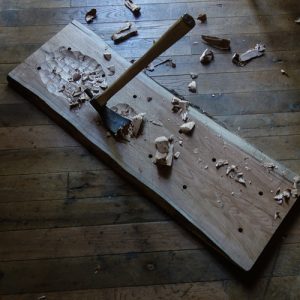 Nearly any wood will work for a Windsor chair seat. It depends on how much work you are willing to do and how heavy a chair you want to move every time you finish dinner. I refuse to use anything but the highest quality and most easily worked materials available. In my experience, this is even more important for the beginner; far better to start with the very best, for then you’ll know whether to blame the wood or another factor.
Nearly any wood will work for a Windsor chair seat. It depends on how much work you are willing to do and how heavy a chair you want to move every time you finish dinner. I refuse to use anything but the highest quality and most easily worked materials available. In my experience, this is even more important for the beginner; far better to start with the very best, for then you’ll know whether to blame the wood or another factor.
Easily carved woods like white pine are many times easier to carve than walnut. Walnut is many times easier to carve than elm. Woods with even density throughout (nearly all the woods in this list) are much easier to carve than woods that grow with hard and soft annual layers (yellow pine, ash, etc.). Power tools such as grinders and routers probably negate these differences, but I don’t care to find out. The quiet of my workshop is sacred.
Eastern White Pine
Eastern white pine is what almost all of my traditional chairs are made of. It’s a great carving wood and it’s readily available, though it does have problems with pitch and wind-shake.
Pros: –very easy to carve
–light
–common
–very stable
Cons: –has pitch and gets wind-shake more than other woods
–dents easily
–is easy to pull a chip while drilling or reaming
Tulip Poplar
Not to be confused with the true poplars, aspen and cottonwood. Makes a good hard seat. Good for seating in public areas because of resistance to denting. I don’t like to carve the white sap wood – too much work. I prefer air dried heartwood (the green stuff).
Pros: –common in the SE
–somewhat dent-resistant
–drills cleanly
–has heartwood that is easy to carve
–fairly stable
Cons: –makes the chair heavier than white pine
–has sapwood that is hard to carve
Basswood
Serviceable but not my favorite, kind of fuzzy and has some mean streaks.
Pros: –very easy to carve
–light
–drills clean
Cons: –dents easily
–bland if not painted
Sugar pine
From out west. Works fine, similar to eastern white pine.
Ponderosa pine
You can use it, although the difference in hardness between early and late wood is greater than in white or sugar pines, but not as much as southern yellow pine (which is impossibly hard).
Alder
Petty hard, but if it’s all you have, use it.
Catalpa
Makes excellent seats and is fairly easy to carve. Beautiful, creamy white wood, sometimes curly.
Buckeye
Easy enough to carve. Not terribly attractive, but looks fine under paint.
Sycamore
Not real easy to carve, but not quite as hard as walnut. Medium weight.
Butternut
This is my favorite, but I would never make a traditional chair out of it because I paint my traditional work. It is going extinct. Butternut is soft enough to carve beautifully, hard enough to hold its edge for clarity, has no pitch problems like pine, no crazy grain problems like basswood
Pros: –very easy to carve
–beautiful in color and grain for unpainted chairs
–light
–drills cleanly
Cons: –dents easily
–rare and getting rarer
–expensive
Walnut
Makes a pretty seat, but is three times harder to carve than white pine.
Pros: –beautiful in color and grain for unpainted chairs
–drills cleanly
–Doesn’t dent easily
Cons: –hard to carve
–heavy
–expensive
Elm
Has interlocking grain, so it’s a real bear to carve. Maybe that’s why English Windsors (sometimes made with elm seats) have such shallow seats. The interlocking grain can help keep the seat from splitting it you aren’t using stretchers. It can have interesting grain patterns that look good unpainted.

What are your feelings about White Ash, Elia?
I’ve never used it for seats, but it’s heavy and hard and ring-porous; it would be hard to carve and make a heavy chair. But it could be done.
How about Norway maple? I have a big tree that need to come down and was thinking of using some of it for seats.
I’ve never used Norway Maple, but one good way to compare woods is to look up the specs on https://www.wood-database.com
It is about as heavy and hard as ‘hard maple’, which would make a very heavy chair and would be very tough to carve with handtools. It’s possible, but it would be many time more work than tuilip poplar or white pine.
Thanks Elia! This is a great list and very helpful 🙂